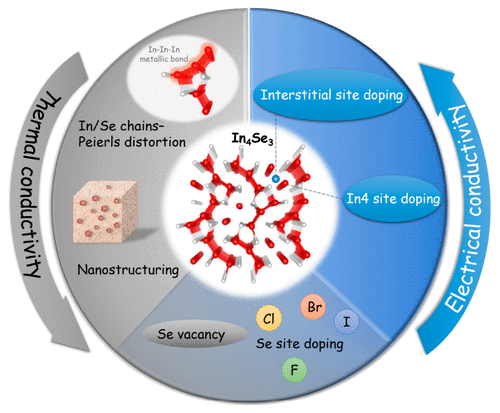当前位置:
X-MOL 学术
›
Acc. Chem. Res.
›
论文详情
Our official English website, www.x-mol.net, welcomes your
feedback! (Note: you will need to create a separate account there.)
High Thermoelectric Performance of In4Se3-Based Materials and the Influencing Factors
Accounts of Chemical Research ( IF 16.4 ) Pub Date : 2018-01-09 00:00:00 , DOI: 10.1021/acs.accounts.7b00480 Xin Yin 1 , Jing-Yuan Liu 1 , Ling Chen 1 , Li-Ming Wu 1
Accounts of Chemical Research ( IF 16.4 ) Pub Date : 2018-01-09 00:00:00 , DOI: 10.1021/acs.accounts.7b00480 Xin Yin 1 , Jing-Yuan Liu 1 , Ling Chen 1 , Li-Ming Wu 1
Affiliation

|
Materials that can directly convert electricity into heat, i.e., thermoelectric materials, have attracted renewed attention globally for sustainable energy applications. As one of the state-of-the-art thermoelectric materials, In4Se3 features an interesting crystal structure of quasi-two-dimensional sheets comprising In/Se chains that provide a platform to achieve a Peierls distortion and support a charge density wave instability. Single-crystal In4Se3−δ (δ = 0.65) shows strong anisotropy in its thermoelectric properties with a very high ZT of 1.48 at 705 K in the b–c plane (one of the highest values for an n-type thermoelectric material to date) but a much lower ZT of approximately 0.5 in the a–b plane. Because of the random dispersion of grains and the grain boundary effect, the electrical transport properties of polycrystalline In4Se3 are poor, which is the main impediment to improve their performance. The In4-site in the In4Se3 unit cell is substitutional for dopants such as Pb, which increases the carrier concentration by 2 orders of magnitude and the electrical conductivity to 143 S/cm. Furthermore, the electrical conductivity markedly increases to approximately 160 S/cm when Cu is doped into the interstitial site but remains as low as 30 S/cm with In1/In2/In3-site dopants, e.g., Ni, Zn, Ga, and Sn. In particular, the In4-site dopant ytterbium introduces a pinning level that highly localizes the charge carriers; thus, the electrical conductivity is maintained within an order of magnitude of 30 S/cm. Meanwhile, ytterbium also creates resonance states around the Fermi level that increase the Seebeck coefficient to −350 μV/K, the highest value at the ZT peak. However, the maximum solubility of the dopant may be limited by the Se-vacancy concentration. In addition, a Se vacancy also destroys the regular lattice vibrations and weakens phonon transport. Finally, nanoinclusions can effectively scatter the middle wavelength phonons, resulting in a decrease in the lattice thermal conductivity. Because of the multiple-dopant strategy, polycrystalline materials are competitive with single crystals regarding ZT values; for instance, Pb/Sn-co-doped In4Pb0.01Sn0.04Se3 has ZT = 1.4 at 733 K, whereas In4Se2.95(CuI)0.01 has ZT = 1.34 at 723 K. These properties illustrate the promise of polycrystalline In4Se3-based materials for various applications. Finally, the ZT values of all single crystalline and polycrystalline In4Se3 materials have been summarized as a function of the doping strategy applied at the different lattice sites. Additionally, the correlations between the electrical conductivity and the Seebeck coefficient of all the polycrystalline materials are presented. These insights may provide new ideas in the search for and selection of new thermoelectric compounds in the In/Se and related In/Te, Sn/Se, and Sn/Te systems.
中文翻译:

In 4 Se 3基材料的高热电性能及其影响因素
可将电能直接转化为热能的材料,即热电材料,在可持续能源应用领域引起了全球的重新关注。作为最先进的热电材料之一,In 4 Se 3具有包含In / Se链的准二维薄片的有趣晶体结构,该晶体提供了实现Peierls变形并支持电荷密度波的平台不稳定。单晶In 4 Se 3−δ(δ= 0.65)在其热电特性中表现出很强的各向异性,并且在b–c平面上在705 K处的ZT非常高,为1.48 (n型热电材料的最大值之一)迄今为止),但ZT却低得多在a–b平面中大约为0.5 。由于晶粒的随机分散和晶界效应,多晶In 4 Se 3的电输运性能较差,这是提高其性能的主要障碍。In 4 Se 3中的In4-位晶胞可替代Pb等掺杂剂,从而将载流子浓度提高2个数量级,并将电导率提高到143 S / cm。此外,当将Cu掺杂到间隙位置中时,电导率显着增加到大约160 S / cm,但是使用In1 / In2 / In3-位掺杂剂(例如Ni,Zn,Ga和Sn)保持低至30 S / cm的电导率。特别是,In4位掺杂物ant引入了一种钉扎能级,可将电荷载流子高度定位。因此,电导率保持在30 S / cm的数量级内。同时,还会在费米能级附近产生共振态,从而将塞贝克系数提高到-350μV/ K,这是ZT时的最大值顶峰。但是,掺杂剂的最大溶解度可能受到硒空位浓度的限制。此外,硒的空位也会破坏规则的晶格振动并削弱声子的传输。最后,纳米夹杂物可以有效地散射中波声子,导致晶格热导率降低。由于采用了多掺杂策略,因此多晶材料在ZT值方面可与单晶竞争。例如,铅/锡-共掺杂In 4的Pb 0.01锡0.04硒3已ZT = 1.4,在733 K,而在4硒2.95(CUI)0.01具有ZT在723 K时= 1.34。这些性质说明了多晶In 4 Se 3基材料在各种应用中的前景。最后,总结了所有单晶和多晶In 4 Se 3材料的ZT值,作为在不同晶格位置施加的掺杂策略的函数。另外,给出了所有多晶材料的电导率和塞贝克系数之间的相关性。这些见解可以为In / Se和相关In / Te,Sn / Se和Sn / Te系统中新的热电化合物的搜索和选择提供新思路。
更新日期:2018-01-09
中文翻译:

In 4 Se 3基材料的高热电性能及其影响因素
可将电能直接转化为热能的材料,即热电材料,在可持续能源应用领域引起了全球的重新关注。作为最先进的热电材料之一,In 4 Se 3具有包含In / Se链的准二维薄片的有趣晶体结构,该晶体提供了实现Peierls变形并支持电荷密度波的平台不稳定。单晶In 4 Se 3−δ(δ= 0.65)在其热电特性中表现出很强的各向异性,并且在b–c平面上在705 K处的ZT非常高,为1.48 (n型热电材料的最大值之一)迄今为止),但ZT却低得多在a–b平面中大约为0.5 。由于晶粒的随机分散和晶界效应,多晶In 4 Se 3的电输运性能较差,这是提高其性能的主要障碍。In 4 Se 3中的In4-位晶胞可替代Pb等掺杂剂,从而将载流子浓度提高2个数量级,并将电导率提高到143 S / cm。此外,当将Cu掺杂到间隙位置中时,电导率显着增加到大约160 S / cm,但是使用In1 / In2 / In3-位掺杂剂(例如Ni,Zn,Ga和Sn)保持低至30 S / cm的电导率。特别是,In4位掺杂物ant引入了一种钉扎能级,可将电荷载流子高度定位。因此,电导率保持在30 S / cm的数量级内。同时,还会在费米能级附近产生共振态,从而将塞贝克系数提高到-350μV/ K,这是ZT时的最大值顶峰。但是,掺杂剂的最大溶解度可能受到硒空位浓度的限制。此外,硒的空位也会破坏规则的晶格振动并削弱声子的传输。最后,纳米夹杂物可以有效地散射中波声子,导致晶格热导率降低。由于采用了多掺杂策略,因此多晶材料在ZT值方面可与单晶竞争。例如,铅/锡-共掺杂In 4的Pb 0.01锡0.04硒3已ZT = 1.4,在733 K,而在4硒2.95(CUI)0.01具有ZT在723 K时= 1.34。这些性质说明了多晶In 4 Se 3基材料在各种应用中的前景。最后,总结了所有单晶和多晶In 4 Se 3材料的ZT值,作为在不同晶格位置施加的掺杂策略的函数。另外,给出了所有多晶材料的电导率和塞贝克系数之间的相关性。这些见解可以为In / Se和相关In / Te,Sn / Se和Sn / Te系统中新的热电化合物的搜索和选择提供新思路。











































 京公网安备 11010802027423号
京公网安备 11010802027423号